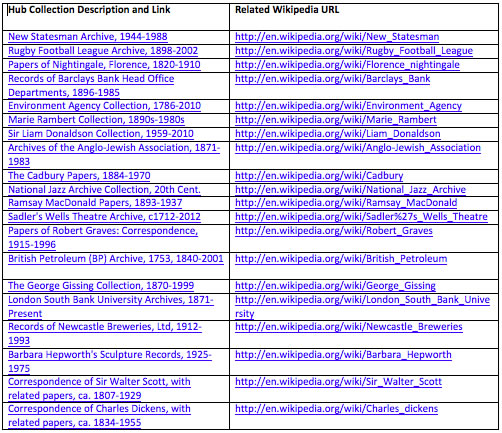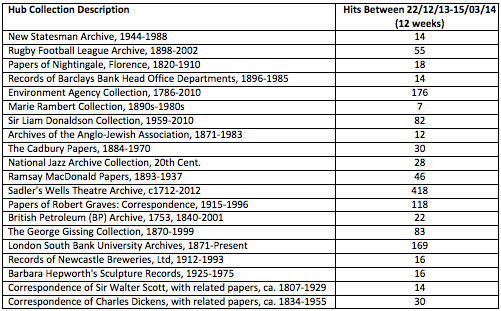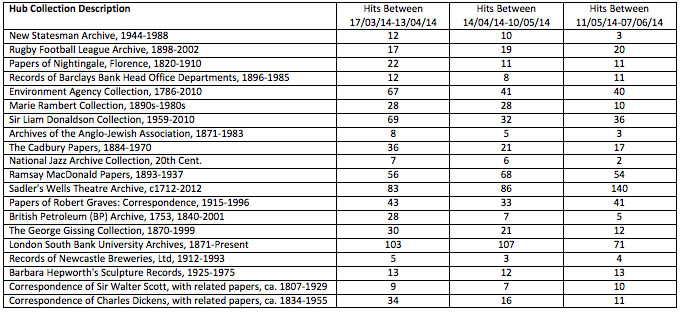WikiLinks – Guest Blog by Andy Young
Between March and June 2014 I conducted a piece of social media-oriented research on behalf of the Archives Hub, the primary purpose of which was to measure the impact of adding links from specific Wikipedia articles featuring Hub content on the traffic that comes into the Hub website. As well as providing the Hub administrators – and, indeed, the profession as a whole – with a gauge as to whether the amount of time invested in creating links is worthwhile when compared to the benefits of impact, this research benefitted me personally in that it allowed me the opportunity to potentially earn credits on the Archives & Records Association’s Registration Scheme, under the ‘Contributions to the profession’ category.
The first phase of the study involved me identifying twenty archival collections listed in the Hub, with no existing links to related Wikipedia pages, which I could treat as measurable research subjects. This was done simply by entering specific Hub collection level descriptions into the Wikipedia search engine. (If a link to the Hub had already been created, I eliminated that particular collection from the study.) In order to achieve a fair and balanced piece of research, I selected collections of a relatively similar size and status, and avoided those relating to any significant public events running concurrent to, or immediately prior to, the commencement of the research, i.e. local elections in England, the World Cup. My feeling was that such collections could have been subject to closer scrutiny from researchers while the study was underway, which, in turn, would have resulted in an unexpected increase in Hub-searching activity. This, in essence, would have undermined the credibility of the study. I also made sure that the Wikipedia pages I utilised didn’t already include links to the collection-holding repositories, as this could potentially sway researchers away from clicking the newly-created links to the Hub descriptions, thereby affecting the accuracy of research.
The twenty collections selected, along with their corresponding Wikipedia links, are shown in the table below.

Once the Hub collections and related Wikipedia pages had been identified, I then added new links to the individual pages using Wikipedia’s built-in editing tool. In the interests of consistency, I embedded each new link in the ‘External Links’ section on each of the pages I modified. I then used Google Analytics, in conjunction with an Excel spreadsheet, to collate and record Hub traffic data for each individual collection for the twelve-week period prior to the start of the study, specifically from the 22nd December, 2013 to the 15th March, 2014. This was done in order to enable me to generate a measurement of the overall impact of the newly-created links on incoming Hub traffic. The cumulative results for each collection, for the twelve-week period prior to the commencement of the study, are shown below.

Over the course of the next twelve weeks, from the 17th March, 2014 to the 7th June, 2014, I used Google Analytics once again to monitor incoming Hub traffic, with a reading being taken at the end of every fourth week in order to identify any significant traffic fluctuations or changes. The four-week hit statistics for each of the twenty collections are shown in the table below.

At the end of the twelve-week research period it was evident from the accumulated data that fourteen of the twenty collections had each experienced an increase in traffic compared to the previous twelve-week period. Indeed, of the fourteen, two collections, namely the Ramsay MacDonald Papers and the London South Bank University Archives, had each received well in excess of 100 additional hits compared to the pre-link period. Of the remaining six collections, only the Sadler’s Wells Theatre Archive had decreased in hits significantly, down 109 from the previous period. Although it isn’t possible to say definitively why this decrease occurred, it may have been due to the fact that at some point during the research, a new link had been added to the Sadler’s Wells Theatre Archive Wikipedia page giving researchers the option to examine ‘Archival material relating to Sadler’s Wells Theatre listed at the UK National Archives.’ Taking this modification into account, it seems fair to suggest that any researchers interested in the Sadler’s Wells Theatre material may have been drawn to this link description rather than the newly-added link to the Hub description essentially because it makes mention of the country’s principal archival repository, TNA.
The cumulative number of hits for each of the twenty collections during the research period are presented in the table below. This table also shows the positive and negative numerical differences in hits for each of the collections compared to the twelve-week period prior to the start of the research.

Conclusion
This piece of research has demonstrated that the simple task of linking online archival descriptions to a popular social media reference tool such as Wikipedia can yield extremely positive results. It has shown, moreover, that there are clear benefits, both for the archival repository/aggregator and the individual researcher, when catalogue data is linked and shared. Not only that, it has proven that a successful outcome can be achieved in a relatively short space of time, and, truth be told, with only a small amount of physical effort. The process of checking whether links from specific Hub collections already existed in Wikipedia and then adding them to the website if they didn’t, took little more than three hours to complete, and, for the most part, basically involved me copying data from one website and pasting it onto another. Ultimately, the sheer simplicity of this exercise, coupled with the knowledge that interest in the vast majority of the Hub collections increased as a result of the Wikipedia editing, confirms, to my mind at least, that archive services the world over – especially those blessed with a healthy number of volunteers – would benefit from embarking on linked data projects of this nature. After all, it’s like Benjamin Franklin said, “An investment in knowledge always pays the best interest.”
